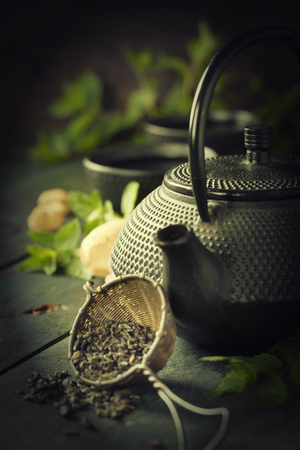Introduction to British Garden Herbs
The tradition of cultivating herbs in British gardens is woven deeply into the fabric of UK culture and daily life. For centuries, Britons have nurtured herbaceous borders and kitchen plots, using locally grown plants not only to flavour food but also to brew restorative teas and enhance wellbeing. These gardens are more than just picturesque features; they are practical spaces that reflect a longstanding appreciation for nature’s remedies. From the classic English cottage garden filled with mint, chamomile, and lemon balm, to urban allotments boasting thyme and sage, growing herbs for tea has become a cherished pastime. Beyond their culinary uses, these versatile plants have historically played an essential role in home health practices, offering gentle support for digestion, relaxation, and general vitality. This enduring tradition is a testament to the British commitment to sustainability and natural living, as homegrown herbs continue to connect people with the rhythms of the seasons and the therapeutic potential of their own back gardens.
Popular British Herbs for Tea
British gardens are renowned for their abundance of herbs that not only enhance culinary experiences but also make delightful herbal teas. Among the most cherished are mint, chamomile, lemon balm, and rosemary—each offering distinct flavours and wellbeing benefits. These herbs thrive in the UKs temperate climate and have become staples in many households.
Mint: The Classic Refreshment
Mint is perhaps the most iconic British garden herb used for tea. Its invigorating aroma and cooling taste make it a favourite, especially after meals. Peppermint and spearmint varieties are both widely grown. Mint tea is known to aid digestion and provide a gentle energy boost without caffeine.
Chamomile: Calming and Fragrant
Chamomile, with its delicate apple-like scent, has long been valued for its calming properties. Traditionally sown in cottage gardens, chamomile flowers are harvested and dried for tea that helps promote relaxation and restful sleep—making it a popular evening brew across the UK.
Lemon Balm: Uplifting Zest
Lemon balm offers a subtle citrusy note that brightens any herbal blend. Its soothing qualities support stress relief and mental clarity. Lemon balm grows well in British soils and can be enjoyed on its own or paired with other herbs for a refreshing infusion.
Rosemary: Aromatic Robustness
While rosemary is often associated with savoury dishes, its woody, aromatic flavour lends itself beautifully to herbal teas. Rosemary tea is praised for its antioxidant content and potential cognitive benefits. It thrives in well-drained soil and brings a Mediterranean flair to British gardens.
Comparison of Popular British Tea Herbs
| Herb | Flavour Profile | Main Benefits | Typical Use in Teas |
|---|---|---|---|
| Mint | Cool, refreshing, slightly sweet | Aids digestion, energising | Pure or blended infusions |
| Chamomile | Mild, floral, apple-like | Calming, supports sleep | Bedtime teas, stress relief blends |
| Lemon Balm | Citrusy, light, fresh | Mood lifting, soothes nerves | Mental clarity blends, solo infusions |
| Rosemary | Pine-like, robust, aromatic | Antioxidant-rich, may boost focus | Cognitive support blends, solo sips |
The above herbs not only embody the essence of British gardening traditions but also offer diverse options for those seeking natural ways to enhance their wellbeing through daily tea rituals.

3. Cultivation Essentials
Understanding British Soil Conditions
Successful herb cultivation in the UK starts with assessing your garden’s soil type. Most classic British herbs, such as mint, chamomile, and lemon balm, prefer well-drained, loamy soils with a pH between 6.0 and 7.0. According to data from the Royal Horticultural Society (RHS), over 70% of UK gardens have slightly acidic to neutral soils, making them ideal for a wide range of tea herbs. If your soil is heavy clay or sandy, amend it with organic compost to improve structure and moisture retention.
Optimal Planting Practices
British climates are characterised by moderate rainfall and mild summers, which benefit most perennial and annual herbs. For best results, plant hardy herbs like rosemary and thyme in early spring once the risk of frost has passed—typically late March to mid-April in southern England. For less hardy varieties such as basil, wait until late May or use cloches to protect young plants. Data from the Met Office shows that the growing season in the UK averages 260 days, allowing for successive sowings and continuous harvests.
Spacing and Sunlight Requirements
Herbs require adequate spacing to promote air circulation and prevent fungal diseases common in humid British weather. As a rule of thumb, allow at least 30cm between each herb plant. Most tea herbs thrive in full sun (at least 6 hours daily), but tolerate partial shade—especially in northern regions where sunlight intensity is lower.
Watering and Maintenance Tips
Due to frequent rainfall, overwatering is a common pitfall in British gardens. Use mulches to suppress weeds and retain soil moisture during dry spells, but ensure beds are free-draining to avoid root rot. Regular pruning encourages bushier growth; for example, RHS trials indicate that mint yields increase by up to 25% when cut back monthly during summer. Monitor for slugs and aphids—two prevalent UK pests—and opt for organic controls where possible.
4. Harvesting and Preparation Techniques
Knowing when and how to harvest your garden herbs is essential for maximising both flavour and wellbeing benefits in traditional British herbal teas. Below, you’ll find a step-by-step guide that blends practical advice with classic British methods, ensuring your home-grown ingredients are at their peak.
Step-by-Step Guide to Harvesting Herbs
- Choose the Right Time: The optimal time to harvest most British herbs—such as mint, chamomile, and lemon balm—is just before they flower, usually on a dry morning after the dew has evaporated but before the midday sun becomes too strong. This preserves essential oils and flavour.
- Select Healthy Growth: Use clean, sharp scissors or secateurs to snip off healthy stems. Avoid any leaves that are yellowed or damaged.
- Harvest Gently: Cut no more than one-third of the plant at a time to ensure ongoing growth throughout the season.
Traditional British Drying Methods
| Method | Description | Ideal For |
|---|---|---|
| Air Drying (Bundling) | Tie small bunches of herbs with natural twine and hang upside-down in a warm, well-ventilated area away from direct sunlight. | Mint, Sage, Rosemary |
| Tray Drying | Spread leaves in a single layer on a clean tray lined with kitchen paper. Place in an airy spot, turning occasionally until dry. | Lemon Balm, Chamomile Flowers |
| Oven Drying (Low Heat) | Place herbs on a baking sheet and set the oven to its lowest temperature (ideally below 50°C/120°F). Keep the door slightly ajar and check regularly. | Tougher Woody Herbs (e.g., Thyme) |
Storing Dried Herbs for Tea-Making
- Airtight Storage: Once thoroughly dried, strip leaves from stalks and store them in airtight glass jars or tins. Label with the date of harvest for freshness tracking.
- Cool, Dark Location: Store jars in a cool cupboard away from direct sunlight to maintain flavour and potency for up to one year.
- Avoid Moisture: Always ensure herbs are fully dried before storing; moisture can cause mould and spoilage.
Pro Tip: Traditional Blending
The British tradition often involves blending different dried herbs based on seasonal wellness needs—such as combining mint with chamomile for calm or adding fennel seeds for digestive comfort. Experiment with your own blends using these preparation techniques to create bespoke herbal teas that support your wellbeing all year round.
5. Herbal Tea Blends and Usage
Classic British Herbal Tea Blends
British tea culture is steeped in tradition, with herbal teas offering a delightful alternative to black tea for those seeking caffeine-free options. Classic blends often highlight familiar garden herbs such as mint, chamomile, and lemon balm. A quintessential British favourite is mint tea, made by infusing fresh spearmint or peppermint leaves in hot water—a refreshing and palate-cleansing option, especially after meals. Another staple is chamomile-lavender tea, combining calming chamomile flowers with aromatic lavender sprigs for a soothing bedtime brew. For a gentle citrus note, lemon balm and rosemary can be blended, reflecting the British appreciation for subtle yet uplifting flavours.
Inventive Blends for Modern Palates
Contemporary tastes have inspired more inventive herbal blends that still honour British gardening traditions. Try pairing sage and thyme for a robust, savoury infusion that complements afternoon tea sandwiches. Or blend fennel and apple mint for a naturally sweet, digestive-friendly cup—perfect after a hearty Sunday roast. For a seasonal twist, infuse elderflower with wild strawberry leaves, celebrating the abundance of the English countryside in late spring and early summer.
Tips for Brewing and Serving Herbal Teas
To fully appreciate herbal teas in the British style, use freshly picked or dried herbs from your own garden when possible. Always pour just-boiled water over the herbs and allow them to steep for 5–10 minutes, covered, to preserve essential oils and flavour. Serving herbal teas in a traditional teapot or bone china cup enhances the experience. Accompany with light snacks such as scones or cucumber sandwiches during afternoon tea—a ritual cherished across Britain. Remember that honey or a slice of lemon can add sweetness or brightness without overpowering delicate herbal notes.
Cultural Insights: Tea-Time Customs
In line with British customs, herbal teas are often enjoyed as part of daily rituals: mid-morning breaks, afternoon gatherings, or as a calming evening wind-down. Offering guests a selection of homegrown herbal blends is considered both hospitable and health-conscious—a reflection of modern British wellbeing trends.
6. Wellbeing Benefits Backed by Research
Incorporating British garden herbs into your daily tea routine is more than a charming tradition—it’s a practice increasingly supported by scientific evidence for its positive impact on wellbeing. Several common herbs cultivated in British gardens, such as chamomile, mint, lemon balm, and rosemary, have been the subject of clinical studies examining their effects on both physical and mental health.
Physical Health: Soothing and Supporting the Body
Research highlights the anti-inflammatory and antioxidant properties present in many garden herbs. For instance, chamomile tea has demonstrated efficacy in supporting digestive health and reducing symptoms of mild gastrointestinal discomfort (National Institute for Health and Care Excellence, UK). Peppermint tea, derived from home-grown Mentha × piperita, is widely recognised for its ability to ease irritable bowel syndrome (IBS) symptoms by relaxing gastrointestinal tissue, as confirmed by randomised controlled trials published in The BMJ. Additionally, rosemary infusions have shown potential in supporting cardiovascular health due to their high concentration of rosmarinic acid—a potent antioxidant.
Mental Health: Calming the Mind
The mental health benefits of herbal teas are equally compelling. Lemon balm (Melissa officinalis), often found in British herb patches, has been shown in University of Northumbria studies to enhance mood and improve cognitive performance. Chamomiles calming properties are also well-documented, with multiple double-blind studies indicating reduced anxiety levels after regular consumption. The ritual of preparing and enjoying a cup of freshly brewed herbal tea itself can promote mindfulness and relaxation—qualities highly valued in contemporary British wellness culture.
Sustainable Wellbeing: Everyday Herbal Rituals
Adopting garden-grown herbal teas into everyday life offers a sustainable approach to wellbeing that aligns with British values of self-sufficiency and eco-conscious living. By nurturing these herbs at home and using them fresh or dried, individuals can reduce reliance on mass-produced products while reaping scientifically validated health benefits.
Conclusion: Evidence-Informed Tradition
Modern research reinforces what British gardeners have known for generations: integrating home-grown herbs into daily tea rituals provides tangible health advantages for body and mind. Whether seeking relief from minor ailments or simply aiming to enhance daily tranquillity, the science supports making these time-honoured plants a staple of everyday wellbeing.
7. Sustainable Practices and Community Culture
Across the UK, sustainable gardening is increasingly shaping how herbs are grown for tea. Local initiatives such as community herb gardens and eco-friendly allotment projects are flourishing in both urban and rural settings. These projects not only reduce food miles and environmental impact but also foster a strong sense of local identity and community engagement.
Showcasing Local Initiatives
Organisations like Incredible Edible Todmorden and the RHS Britain in Bloom encourage residents to cultivate herbs such as mint, lemon balm, and chamomile in shared public spaces. These efforts provide access to fresh, organic ingredients for home-brewed teas while promoting biodiversity and pollinator health.
Eco-Friendly Gardening Tips
- Composting: Use homemade compost to enrich soil naturally and reduce waste.
- Rainwater Harvesting: Collect rainwater for irrigation, reducing reliance on mains water.
- Pesticide-Free Methods: Encourage natural predators like ladybirds or use companion planting to control pests instead of chemicals.
The Rise of Community Herb Gardens
Many British towns now boast dedicated herb beds in parks or communal spaces. Residents share responsibilities such as watering and harvesting, ensuring an ongoing supply of fresh herbs for everyone’s tea blends. These gardens often become hubs for workshops on herbal wellness, sustainable cultivation, and traditional British tea rituals.
A Positive Impact on Wellbeing
The social aspect of community gardening—whether sharing cuttings or swapping recipes—strengthens neighbourhood bonds and supports mental wellbeing. Adopting eco-friendly practices within these local networks not only benefits the environment but also cultivates a culture of collective care that is central to the British gardening ethos.

